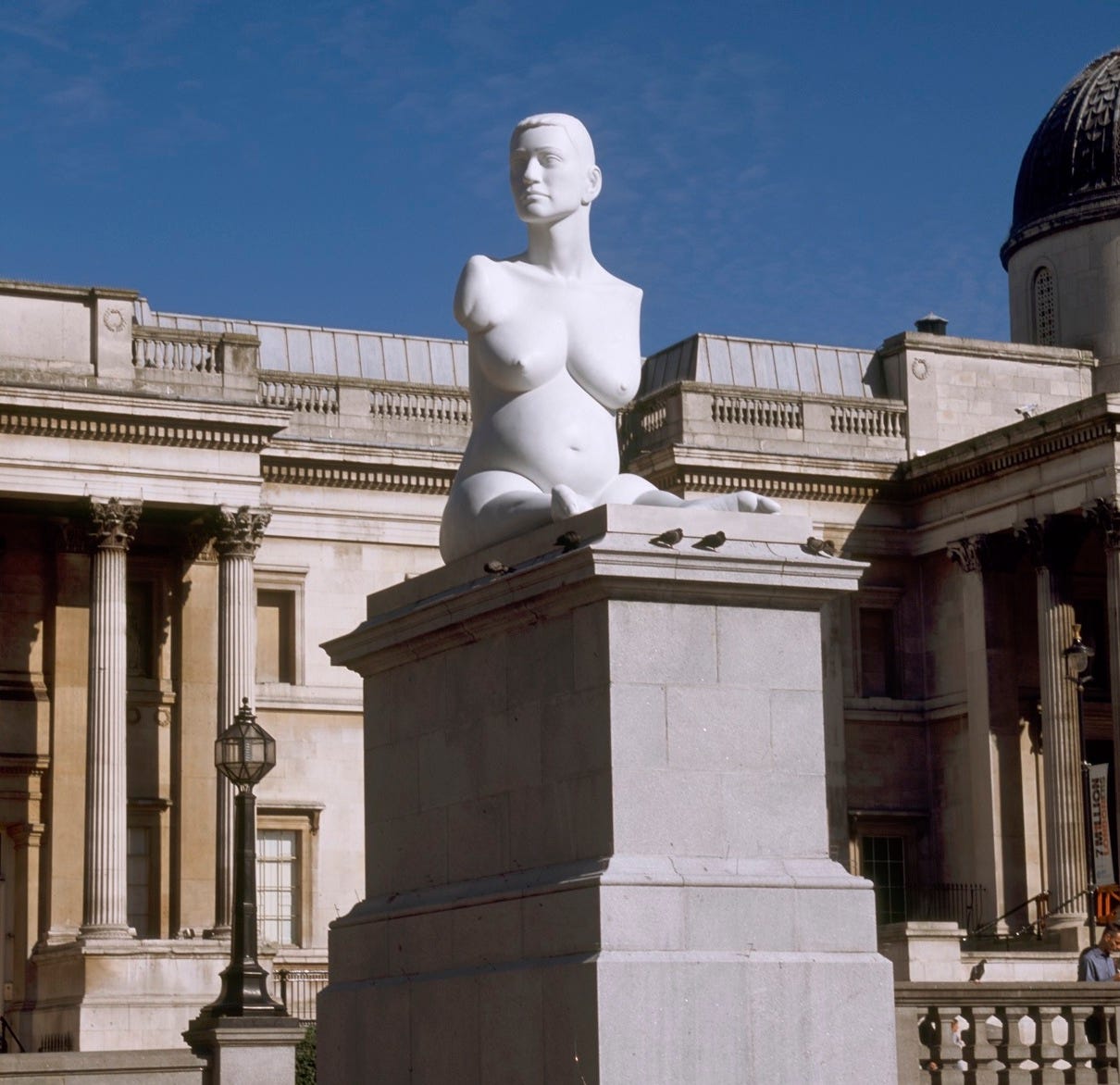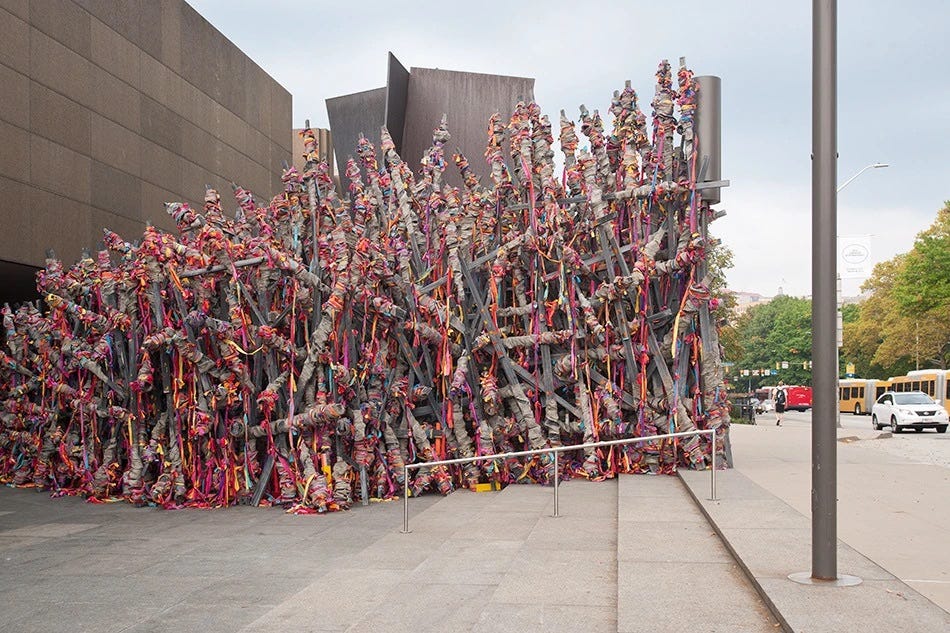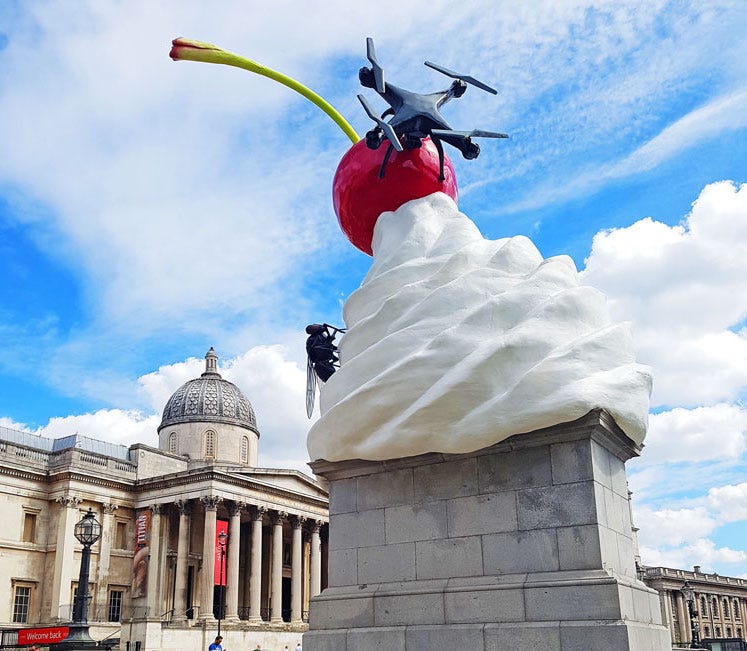Is Sustainable Art Practice Possible?
London's Fourth Plinth project, Phyllida Barlow and what to do with unsold art
Last week the issue of the validity and form of civic art was once again in the news, but not for the familiar reasons we’ve heard a lot about in recent years over the commemoration of questionable historical figures. The British artist Rachel Whiteread called for the end of the Fourth Plinth project, a popular public art competition funded by the London Mayor’s office. Every two years since 1999 a different artist has been commissioned to fill the empty fourth plinth in London’s Trafalgar Square with a work of art voted for by the public.
This project is important. For a start it champions contemporary art. It’s a rare opportunity for artists to receive significant funding to make and show their work on a large scale in public. And it veers away from the traditionally figurative (and some may say safe) formula that most public sculpture commissions tend towards. Just think about the recent sculpture of Diana in Kensington Palace Gardens for example, or the statue of former British Prime Minister Margaret Thatcher in Grantham.
There’s nothing dull or traditional about the commissions for this prize. From Marc Quinn’s Alison Lapper Pregnant (2005) to Yinka Shonibare’s Nelson’s Ship in a Bottle (2010) and Heather Phillipson’s The End (2020) the art that we have seen over the years has drawn dramatic and thought-provoking attention to some of the most important issues of our day.

That’s one of the great strengths of contemporary art: it provides viewers with a way to contemplate often difficult and unspoken ideas, thoughts and feelings. Furthermore, it’s in a public place where anyone can encounter it, whether you’re comfortable with art or not. It gets art seen outside of museums and private galleries, which can be intimidating spaces for many people to enter. Those are some huge ticks in its favour.
In 2001 Whiteread herself was commissioned to make Monument, a cast in resin of the fourth plinth. The piece was typical of her large-scale sculptural work. What’s her beef with the Fourth Plinth project then? The afterlife. What to do with these enormous artworks after they come down. They remain the property of the artist, who has to either store it (expensive given the size) or find another site for it (not an easy task as it turns out). Most of the previous commissions are sitting in storage collecting dust.
I appreciate that this is a pricey headache for the artists concerned. And it raises a bigger issue about sustainable art practice. Many artists are now increasingly thinking about their footprint, from materials and transport to the storage of unsold work. Although a lot of artists are natural hoarders it’s not always possible to work with salvaged materials.
It’s an issue that the sculptor Phyllida Barlow has talked about recently. Barlow constructs her large-scale works from cheap commercial timber and exhibits all around the world. The question of how to reduce the impact of her work on the environment is one she admits she has no answer to. Should she break up her work and reuse the materials? But then that has commercial implications. Should she not exhibit work abroad? Should she change her practice completely? It’s an interesting 5 minute watch:
Rachel Whiteread’s solution to the redundancy of the Fourth Plinth sculptures after they come down is to just do away with the project altogether. She suggests instead that it would be interesting to leave the plinth empty, that the history of the programme could have a nearby board commemorating it, or it could be on an app.
This suggestion from one of our leading contemporary artists surprised me greatly. Artists have a really important role to play in communicating ideas in ways that actually connect with people, so doing away with the art altogether doesn’t seem like something we should advocate for. As Barlow says the problem is layered, and there is no clear and obvious solution. Except that artists in general tend to find creative ways to work through issues, and are more inclined to be part of the solution than the problem.
I remember taking a group of students to the National Gallery a couple of years ago when Phillipson’s The End was on display. As we passed through Trafalgar Square I stopped the group to discuss the sculpture. I had intended it to be just a quick chat, but we stood there for 45 minutes talking about their interpretations and what it meant to them, connecting the artwork to ideas about surveillance, government, freedom, place, architecture, the city. This kind of art is invaluable even if it can’t be preserved in the long-term.
Perhaps one solution would be to revise the Fourth Plinth brief so that there is a requirement for the artwork to be fully recyclable. The process of construction, transport, disassembly and recycling could be included within the budget if the sculpture does not find a home within a certain amount of time. This seems preferable to getting rid of the project altogether.
I’d love to know what you think about any of these thoughts and ideas.





Nothing is ever simple is it? All we can do is to try and minimise our footprint as much as possible. I do think what artists do is too important for them to stop doing it altogether or to stop exhibiting.
It’s a juicy question isn’t it? I’m kind of surprised (and not) that these works are just sat in storage, I’m guessing the big galleries have similar challenges in storing and displaying collections. I wonder if you added up all the storage costs of the V&A /tate etc with heating/lighting etc and did an environmental impact assessment what we’d find?
I think she makes a fair point about the responsibility attached to commissioning these big pieces. I would worry about what we’d lose or never see if that platform wasn’t available, but the fashion industry and architecture continues to prove that sustainability doesn’t have to be at odds with aesthetic or desirability.
I’m still really bowled over by our virtual gallery experience in London last year to see New Fiction https://www.serpentinegalleries.org/whats-on/acute-art-presents-kaws-new-fiction/ with the looming figures hanging about on the ceiling and in the courtyard, but of course there’s a cost to creating digital that is often not calculated too.